| |||||
| Decades: | |||||
|---|---|---|---|---|---|
| See also: | |||||
Events from the year 1949 in Romania. The year saw the introduction of collectivization and the first Romanian identity card.
| |||||
| Decades: | |||||
|---|---|---|---|---|---|
| See also: | |||||
Events from the year 1949 in Romania. The year saw the introduction of collectivization and the first Romanian identity card.
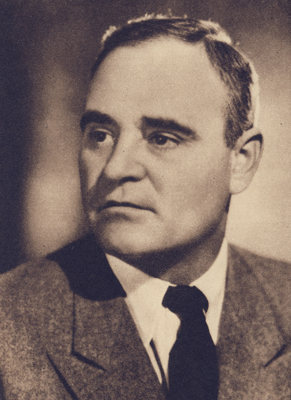
Gheorghe Gheorghiu-Dej was a Romanian politician and electrician. He was the first Communist leader of Romania from 1947 to 1965, serving as first secretary of the Romanian Communist Party from 1944 to 1954 and from 1955 to 1965, and as the first Communist Prime Minister of Romania from 1952 to 1955.
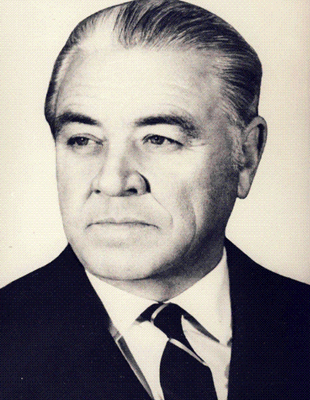
Ion Gheorghe Iosif Maurer was a Romanian communist politician and lawyer, and the 49th Prime Minister of Romania. He is the longest serving Prime Minister in the history of Romania.

The Ploughmen's Front was a Romanian left-wing agrarian-inspired political organisation of ploughmen, founded at Deva in 1933 and led by Petru Groza. At its peak in 1946, the Front had over 1 million members.
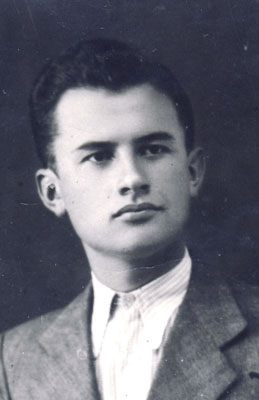
Ion Vincze was a Romanian communist politician and diplomat. An activist of the Romanian Communist Party (PCR), he was married to Constanța Crăciun, herself a prominent member of the party.
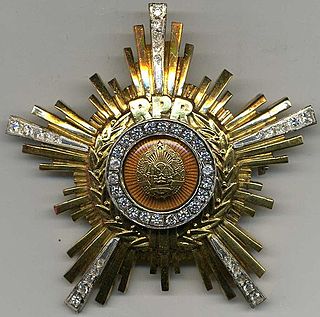
The Order of the Star of the Socialist Republic of Romania, from 1948 to 1965 the Order of the Star of the Romanian People's Republic, was the second-highest honor bestowed by the Socialist Republic of Romania. Established on 12 January 1948, during the regime's first month, it came in five classes:

Iosif Rangheț was an Austro-Hungarian-born Romanian communist activist and politician.
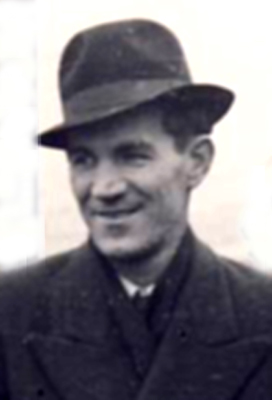
Constantin Doncea was a Romanian communist activist and politician. A railway worker, he played an important part in the Grivița Strike of 1933. Subsequently, imprisoned, he escaped and ended up in Moscow. He then joined the International Brigades during the Spanish Civil War. After spending much of World War II in the Soviet Union, he returned to Romania, where he helped establish a Communist regime. Doncea held a series of posts under the new order, but in 1958 he was removed from the party after clashing with its leader Gheorghe Gheorghiu-Dej. In his later years, he was rehabilitated by the latter's successor, Nicolae Ceaușescu.
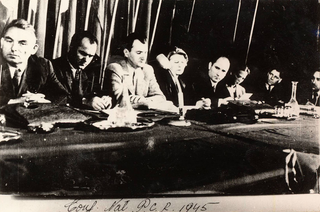
Events from the year 1945 in Romania. The year saw the end of Romania's involvement in World War II and the foundation of the pro-Communist government of Petru Groza.
Events from the year 1947 in Romania. The year saw the abdication of Michael I of Romania and foundation of the Romanian People's Republic.
Events from the year 1948 in Romania. The year saw the formalisation of the Romanian People's Republic.
Events from the year 1946 in Romania. The year started with the end of the royal strike and ended with the Romanian Communist Party win the first election following the introduction of women's suffrage.

Events from the year 1950 in Romania. The year saw Romania build relationships with other Communist states, including China and East Germany.

Events from the year 1951 in Romania. The year saw the Bărăgan deportations.

Events from the year 1952 in Romania. After a new trade agreement is signed with the Soviet Union, a new constitution affirms ties with the Communist state, indicated by a red star being added to the coat of arms, emblem and flag.
Events from the year 1954 in Romania. The year was marked by the 1954 Romanian blizzard.
Events from the year 1933 in Romania. The year saw the Grivița strikes, the formation of the Little Entente, and the assassination of the Prime Minister Ion G. Duca.
Events from the year 1962 in Romania. The year saw the end of the collectivization of agriculture and increasing de-satellization of Communist Romania as the country last publicly supported the Soviet Union against China and took part is Warsaw Pact army exercises.

Dumitru Petrescu, believed to have been born Gheorghe M. Dumitru, also known as Gheorghe Petrescu and Petrescu-Grivița, was a Romanian general, trade union leader, and Communist Party (PCR) activist. After training as a metalworker in Grivița, he took to left-wing politics, joining the underground communist groups at some point before the railwaymen's strike of February 1933, which he helped organise together with Constantin Doncea and Gheorghe Vasilichi. Arrested by the Romanian Kingdom authorities in its wake, he received a 15-year prison sentence. He broke out of Craiova penitentiary a few months later, together with Vasilichi and Doncea, after overpowering a guard. With support from the International Red Aid, Petrescu made his way into Czechoslovakia, and then headed for the Soviet Union, where he lived until 1944. He worked in publishing and trained as a propagandist at the International Lenin School in Moscow.

Văcărești Prison was a prison located in Bucharest, Romania.